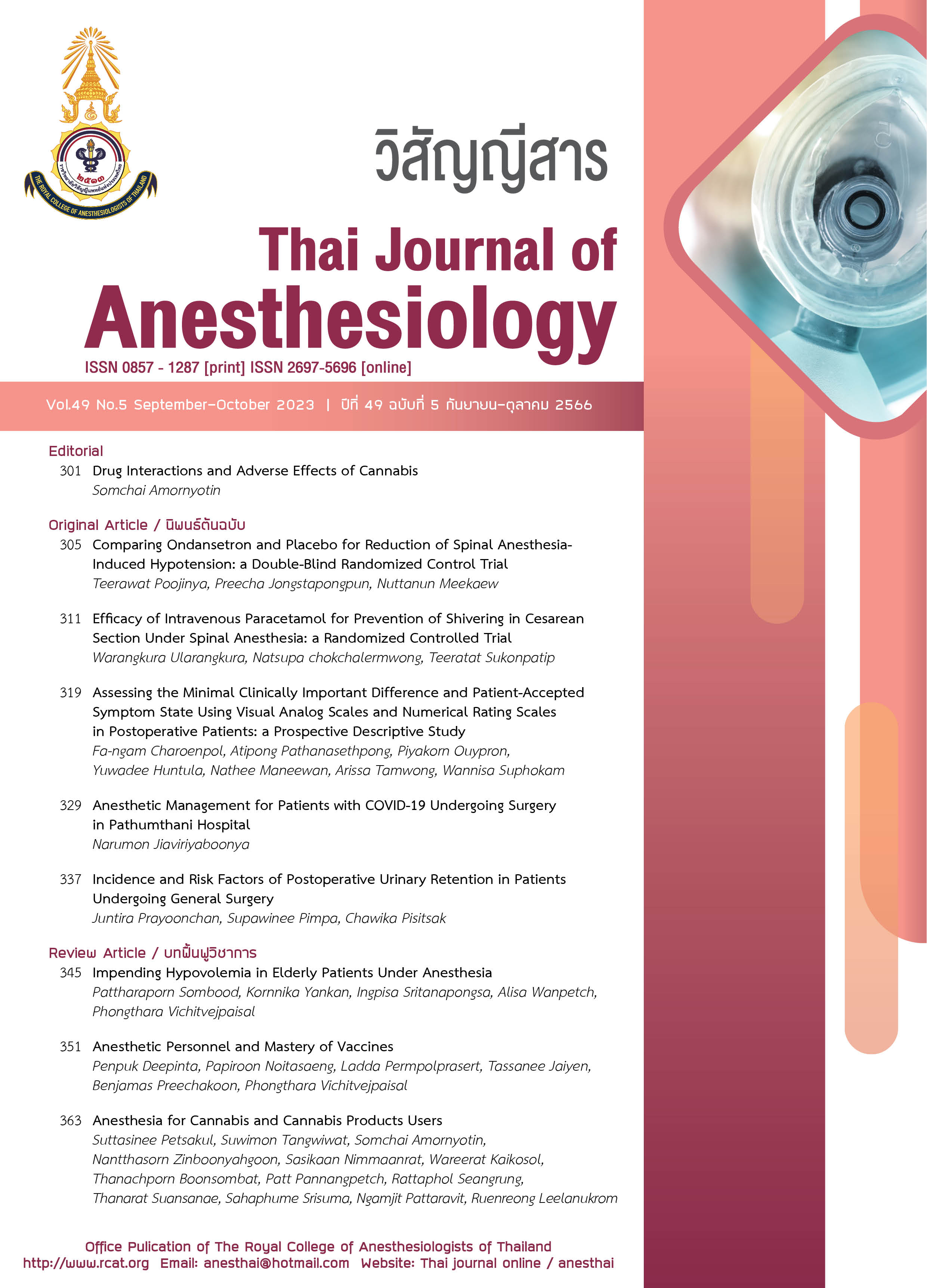Comparing Ondansetron and Placebo for Reduction of Spinal Anesthesia-Induced Hypotension: a Double-Blind Randomized Control Trial
Main Article Content
Abstract
Introduction: Hypotension is the most common side effect of spinal anesthesia. Many interventions, such as administration of intravenous fluids and vasopressor drugs, have been used to minimize or prevent spinal anesthesia-induced hypotension. Animal studies suggest that 5-HT may be an essential factor inducing the Bezold-Jarisch reflex via 5-HT3 receptors in intracardiac vagal nerve endings in the presence of decreased blood volume. The objective of the study is aimed to assess the efficacy of prophylactic intravenous ondansetron in preventing spinal anesthesia-induced hypotension. Methods: 113 patients were enrolled in the double-blind randomized control trial using a computer random-number generator. They were assigned to either the study (ondansetron) group or the control (normal saline) group. Prior to the spinal anesthesia, all patients were preloaded with 10 ml/kg of Ringer’s acetate solution. The study group (n=56) received 8 mg of intravenous ondansetron 5 min prior to spinal anesthesia, whereas the control group (n=57) received 4 ml of normal saline solution. In addition, the blood pressure and heart rate were recorded. Results: Hypotension was presented in 8 patients (14.3%) in the study group and 10 patients (17.5%) in the control group (P=0.636). Bradycardia was observed in 9 patients (16.1%) in the study group; on the other hand, 6 patients (10.5%) in the control group had bradycardia (P=0.385). Conclusion: Intravenous ondansetron administered 5 min prior to spinal anesthesia does not significantly prevent spinal anesthesia-induced hypotension
Article Details

This work is licensed under a Creative Commons Attribution-NonCommercial-NoDerivatives 4.0 International License.
References
Carpenter RL, Caplan RA, Brown DL, Stephenson C, Wu R. Incidence and risk factors for side effects of spinal anesthesia. Anesthesiology. 1992;76:906-16.
Ferré F, Martin C, Bosch L, Kurrek M, Lairez O, Minville V. Control of spinal anesthesia-induced hypotension in adults. Local Reg Anesth. 2020;13:39-46.
Liu SS, McDonald SB. Current issues in spinal anesthesia. Anesthesiology. 2001;94:888-906.
Shimosato S, Etsten BE. The role of the venous system in cardiocirculatory dynamics during spinal and epidural anesthesia in man. Anesthesiology. 1969;30:619-28.
Dobson PM, Caldicott LD, Gerrish SP, Cole JR, Channer KS. Changes in haemodynamic variables during transurethral resection of the prostate: comparison of general and spinal anaesthesia. Br J Anaesth. 1994;72:267-71.
Pollard JB. Cardiac arrest during spinal anesthesia: common mechanisms and strategies for prevention. Anesth Analg. 2001;92:252-6.
Dyer RA, Reed AR, van Dyk D, et al. Hemodynamic effects of ephedrine, phenylephrine, and the coadministration of phenylephrine with oxytocin during spinal anesthesia for elective cesarean delivery. Anesthesiology. 2009;111:753-65.
Campagna JA, Carter C. Clinical relevance of the Bezold-Jarisch reflex. Anesthesiology. 2003;98:1250-60.
Martinek RM. Witnessed asystole during spinal anesthesia treated with atropine and ondansetron: a case report. Can J Anaesth. 2004;51:226-30.
Sahoo T, SenDasgupta C, Goswami A, Hazra A. Reduction in spinal-induced hypotension with ondansetron in parturients undergoing caesarean section: a double-blind randomised, placebo-controlled study. Int J Obstet Anesth. 2012;21:24-8.
Mendonça FT, Crepaldi Junior LC, Gersanti RC, de Araújo KC. Effect of ondansetron on spinal anesthesia-induced hypotension in non-obstetric surgeries: a randomised, double-blind and placebo-controlled trial. Braz J Anesthesiol. 2021;71:233-40.
Shah SARA, Naqvi SS, Abbas MA. Efficacy of prophylactic intravenous administration of ondansetron for prevention of spinal anesthesia induced hypotension in elderly patients. Anaesth Pain Intensive Care. 2016;20:17-20.
Zheng G, Zhang J, Liu J, Chen C, Zhang L, Cao F. A meta-analysis of randomized controlled trials: efficiency and safety of ondansetron in preventing post-anesthesia shivering during cesarean section. Arch Gynecol Obstet. 2023;307:223-31.
Mark AL. The Bezold-Jarisch reflex revisited: clinical implications of inhibitory reflexes originating in the heart. J Am Coll Cardiol. 1983;1:90-102.
Yamano M, Ito H, Kamato T, Miyata K. Characteristics of inhibitory effects of serotonin (5-HT) 3-receptor antagonists, YM060 and YM114 (KAE-393), on the von Bezold-Jarisch reflex induced by 2-Methyl-5-HT, veratridine and electrical stimulation of vagus nerves in anesthetized rats. Jpn J Pharmacol. 1995;69:351-6.
Yamano M, Kamato T, Nishida A, et al. Serotonin (5-HT)3-receptor antagonism of 4, 5, 6, 7-tetrahydrobenzimidazole derivatives against 5-HT-induced bradycardia in anesthetized rats. Jpn J Pharmacol. 1994;65:241-8.
Aviado DM, Aviado DG. The Bezold-Jarisch reflex. A historical perspective of cardiopulmonary reflexes. Ann N Y Acad Sci. 2001;940:48-58.
Kinsella SM, Tuckey JP. Perioperative bradycardia and asystole: relationship to vasovagal syncope and the Bezold-Jarisch reflex. Br J Anaesth. 2001;86:859-68.
Tatikonda CM, Rajappa GC, Rath P, Abbas M, Madhapura VS, Gopal NV. Effect of intravenous ondansetron on spinal anesthesia-induced hypotension and bradycardia: a randomized controlled double-blinded study. Anesth Essays Res. 2019;13:340-6.


